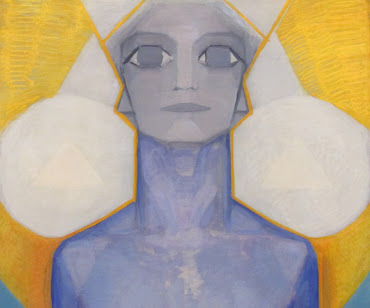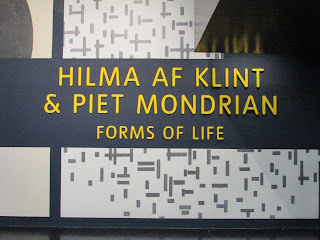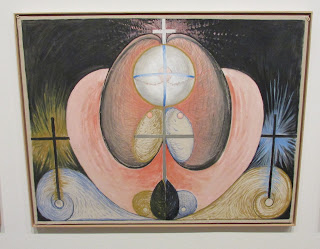Piet Mondrian - Evolution, 1911
I found this to be a really intriguing and enlightening exhibition. I was very familiar with Piet Mondrian's mature works and their adherence to a limited palette and rigorously applied grid system, but I was completely unaware of the influence of nature and Spiritualism upon his earliest works. I am though very aware of the recently discovered and exhibited Spiritualist works of Hilma af Klint which have caused such a sensation wherever they have been exhibited (here) with the justifiable claim to her being one of the very first abstract artists. The exhibition opens with a room devoted to the traditional, atmospheric, early landscapes of both artists, before going on to demonstrate how advances in science such as the microscope and photography and concepts such as the Ether - an invisible energy connecting everything visible, altered human perception to worlds invisible to the naked eye, and impacted the paintings of both which became increasingly abstract. Although both went on to pioneer abstraction, there is a room devoted to the most sensuous depictions of plant and flower studies by both artists. Those of Mondrian are particularly sensitively rendered and a complete surprise given the reduction of his later art to a series of harsh rectilinear grids. Many of Af Klint's paintings although informed by her spirit guide Amaliel in context appear to be too illustrative, as if heavily influenced by biological diagrams which is can be a drawback when viewing the exhibition in parallel to the more free flowing work of Mondrian. Mondrian appears to revel in the sensuality and plasticity of paint. It is really wonderful to see the development of his painting towards pure abstraction in vivid works such as The Blue Tree (1908), and The Red Tree (1908-1910), and how he then breaks forms down to their linear essence in a series of horizontal and vertical lines. I would say that at this point his work is unconcerned with spirituality and more with the process of abstraction. As Af Klint's work develops it too becomes increasingly more abstract and painterly, less reliant on the possible diagrammatic sources culminating in the last room in the exhibition being filled with her joyous series The Ten Largest, huge, colourful feasts for the eye, full of elegant loops and whorls amid a gorgeous colour palette to send visitors exiting the exhibition on their way completely uplifted and inspired.
Hilma af Klint & Piet Mondrian: Forms of Life
until 3rd September
Tate Modern
Bankside
London
SE1












































































No comments:
Post a Comment